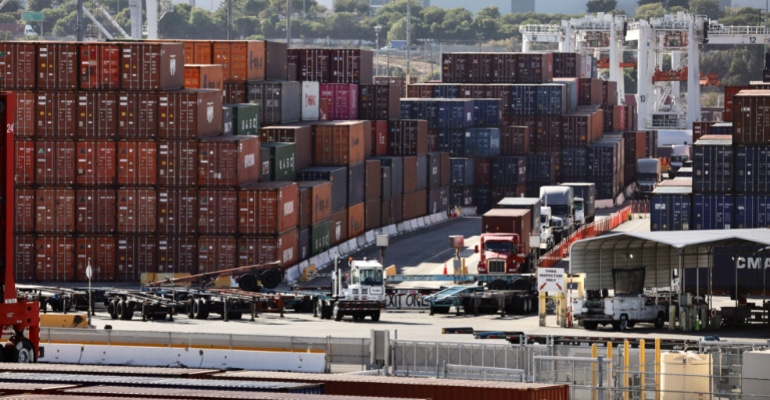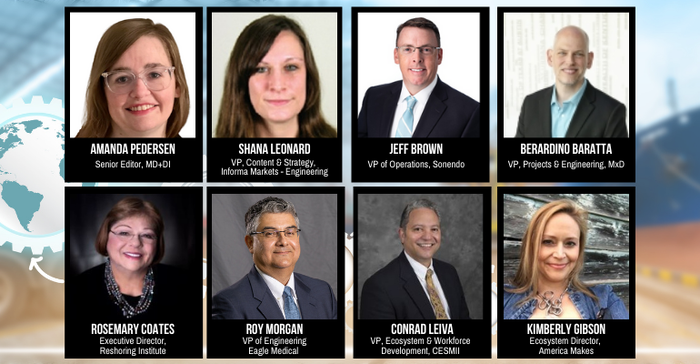In this Let's Talk Medtech Special, recorded at IME West, we explore all aspects of the global supply chain crisis. You'll hear from multiple manufacturing experts who were at the show, in one succinct, narrative-style podcast episode.
April 22, 2022

Can manufacturers rebuild the broken supply chain? Is reshoring the right path out of this supply chain mess? Do smart manufacturing technologies (AI, automation, industrial robots, 3D printing) help offset some of the supply chain challenges? What impact has the supply chain crisis had on relationships between OEMs and suppliers?
These are just some of the questions addressed in this special episode of the Let's Talk Medtech podcast. This narrative-style podcast episode is based on interviews, keynote panel discussions, and other conference sessions at IME West 2022 in Anaheim, CA. The knowledge shared here applies to the broader manufacturing industry including, but not limited to, medical device manufacturing.
Who's in this episode:


Episode 40 transcripts:
Amanda Pedersen:
March 11, 2020: The World Health Organization declares COVID-19 a pandemic.
Jeff Brown:
There was an immense amount of panic buying.
Kimberly Gibson:
We were getting calls to produce PPE.
Jeff Brown:
COVID has exposed the supply chain for its weakness.
Amanda Pedersen:
And people at every level of the supply chain are still grappling with disruptions two years later. I’m Amanda Pedersen, and this is a Let’s Talk Medtech Special: The Global Supply Chain in Crisis.
During the pandemic, supply chain disruption – a topic that once would have put most Americans to sleep – suddenly became a household conversation. It’s headline news and, as Shana Leonard of Informa Markets Engineering points out, it’s even become fodder for late-night comedians like John Oliver.
Shana Leonard:
If it’s on John Oliver it’s an interesting topic – it’s out there in the zeitgeist.
Amanda Pedersen:
So, it wasn’t at all surprising to find that the global supply chain crisis was top of mind last week at IME West in Anaheim, CA. Throughout the three-day event, talk of supply chain challenges and mitigation strategies came up during conference sessions, keynotes, panel discussions and booth visits.
Jeff Brown of Sonedo, describes the supply chain as being like a funnel, and at the bottom of that funnel is a tube. Well, after COVID hit, that funnel of demand became massive. But the supply tube stayed the same.
Jeff Brown:
And it just could not keep up with that demand. We have shortages of trucks, and chassis, we have shortages of truck drivers, we’re not re-circulating our containers back to China so they’re having to make new containers to keep up the flow. It’s just an amazing amount of challenge that COVID has basically exposed the global supply chain for its weaknesses.
Amanda Pedersen:
One such weakness is the lack of visibility into the supply chain – particularly for OEMs who really don’t even know exactly who is in their supply chains. Berardino Baratta of MxD, shared a shocking example from a conversation he had at the beginning of the pandemic.
Berardino Baratta:
A senior executive at a very large manufacturer said, "yeah, we’re not really super worried about China starting to close down because we don’t buy anything from China." Well, five or six levels down, I guarantee you they are. Well, one of the equipment that they buy, that person's buying something from China.
Amanda Pedersen:
So, how’d the United States became so dependent on China in the first place? Well, before 2001 China’s doors were basically closed to manufacturing from outside the country. Rosemary Coates of the Reshoring Institute explained that once China entered into the world trade organization back in 2001, U.S. companies were chomping at the bit to offshore their production lines to China in order to take advantage of China’s very low-cost manufacturing environment. Rosemary, who was working as a management consultant at the time, became the go-to expert for helping companies offshore to China.
Rosemary Coates:
And then the pandemic hits, and we’ve got all these issues that come up. Factories shut down, import demand spikes … there’s a container in Dallas, the Suez Canal gets blocked. It’s like every day I wake up and there’s another new supply chain problem.
Amanda Pedersen:
Reshoring was brought up time and time again at IME West. In particular, a lot of U.S. companies, like Amazon, are considering reshoring to Mexico. In fact, both sides of the Mexican American border are flourishing right now, Rosemary says, because factories are being built on the Mexican side, and warehouses and distribution centers are going up on the U.S. side.
So, is this the beginning of the end of offshoring? Here’s what Berardino said about it.
Berardino Baratta:
It’s not realistic to re-shore everything. And I don’t think we have to.
Amanda Pedersen:
A lot of it comes down to geopolitical relations. Having a manufacturer offshore, but in a friendly nation is a lot different than having them offshore in a contested relationship, Berardino said.
Berardino Baratta:
We need to start thinking about – once we know who’s in our supply chain – start looking at where is the risk, and is there cases where either we as a nation invest – you know, everyone’s aware, or hopefully aware, there’s $50 billion being thrown at building fab’s onshore, but what about all the equipment that goes around the fab? Well, a lot of that could be built in Europe. There's leading companies in Europe that are building it, so how do we partner with someone like Germany, for example, to make sure the ... are in place.
Amanda Pedersen:
He said reshoring considerations should focus on where it makes the most sense. Jeff Brown pointed out that historically, it was a no-brainer to offshore because there were extreme differences in terms of cost. Now, the whole offshore versus re-shore decision is not so cut and dry.
Jeff Brown:
We’re getting into a much more strategic time where we are going to need to look at various raw materials, various sub-assemblies, and supply of other select items to re-shore. It’s not going to be a no brainer, ‘let’s just re-shore everything’ type of situation, right? We're going to have to pick and choose our battles. And in many cases, the financials just don’t make sense to do offshoring anymore. And in some cases, it may not make that much sense to do the reshoring. We're going to have to do a lot of analysis in order to determine what's the optimal mix of getting these products from these various areas, or across the world.
Amanda Pedersen:
In terms of sourcing strategies being considered, I heard a lot of people at IME West talking about a China-plus-one, or a China-plus-two strategy. So perhaps companies won’t be pulling out of China entirely, but they’re beginning to realize that they can’t put all of their eggs into one basket.
As I was walking the exhibit floor at IME West, I stopped to talk to Roy Morgan of Eagle Medical.
Roy Morgan:
Eagle happens to be at a nexus point within the supply chain for our customers as a last operations processor. So, we’re dealing with everything from raw material pellet supply to make films into thermoform trays, paper products, tie back products used to seal those trays, along with components that our customers want integrated into their devices. So we see variations – which is the really interesting thing – in different pieces of the supply chain. In other words, not all supply chains are created equally.
For example, right now the electronics supply chain is just absolutely horrid. We’ve had several electronics integrations for PCBs going into devices, and we’ve been quoted in excess of 35 weeks for delivery. That is a project killer. On the other hand, we’ve seen relatively mild supply chain impacts on the order of an additional, say, four to six weeks. So instead of a regular eight- to 10-week, it might be a 14- to 16-week lead time. So those are a lot more reasonable. But, honestly, right now it runs the entire gamut of what we see. So, we have to juggle it by virtue of the worst player in the overall set of supply chains.
Amanda Pedersen:
So, how do you prioritize that?
Roy Morgan:
Mostly we have to work with our customers to have them understand who are the worst players, and can they find a way to develop alternatives quickly, right? In the regulated industry that we live in, medical device, that’s a very big challenge because of the re-evaluation cost and time involved.
Amanda Pedersen:
Roy said that’s why Eagle recommends that customers, at the outset of product design, consider multiple alternatives to their supply chain sources for materials, components, and especially sterilization.
Roy Morgan:
If it’s a terminally sterilized medical device, always, always consider the possibility of getting two alternative modalities of sterilization simultaneously. That way you don’t have to wait in the longest line, take the shortest one.
Amanda Pedersen:
That type of variation can be tough on the supplier-customer relationship. So, managing expectations for customers is key.
Roy Morgan:
If we over promise and under deliver, our name’s going to be mud in the industry pretty quickly.
Amanda Pedersen:
One of the buzz phrases that kept coming up at the show was just-in-time manufacturing. That refers to manufacturers cutting costs by keeping their inventory very lean rather than building up their safety stock. So, parts were coming through the door 10 minutes before going on the line in some cases. Here’s what Berardino had to say about the dangers of just-in-time manufacturing in today’s supply chain environment.
Berardino Baratta:
Toyota is a famous example, right? Tons of cars were missing because the chips didn’t show up. So, they end up sitting on the lot. It’s not a big deal to carry chips. Yes, they cost money, but they don’t take up a lot of space and you can get a little buffer in there.
Amanda Pedersen:
A common theme throughout IME West was the importance of adopting smart manufacturing technologies such as AI, automation, robotics, etc. Digitalizing factories is one way to tackle the visibility problem in the supply chain, says Conrad Leiva of CESMII – The Smart Manufacturing Institute.
Conrad Leiva:
You need to have a factory or plant that is digital, that is talking more real time where you have internal visibility before you can connect to a network and have that kind of visibility throughout the supply chain.
Amanda Pedersen:
Digitalizing the warehouse space and transportation will also help, Jeff Brown said.
Jeff Brown:
Whether you guys are fans of Tesla or not, I mean, Elon is actually transforming how we are going to be moving product around the world.
Amanda Pedersen:
That doesn’t mean companies have to become fully digital all at once. Berardino shared an example of a major manufacturer of lawn mowers and compact tractors.
Berardino Baratta:
This is a factory out of the ‘80s. There’s a sprinkling of tech in there, but you would think, walking through it, that this is very low tech. It’s actually not, because what they did was, they focused on the key elements that allowed them to get the benefits of digital. … It’s not about transforming your whole factory; it’s about looking at where your challenges are and adopting digital to solve that problem.
Amanda Pedersen:
Cross-industry collaboration, like what we saw at the beginning of the pandemic, is another potential solution, said Kimberly Gibson of America Makes.
Kimberly Gibson:
We were getting calls to produce PPE. … But everyone’s doors were shut, right? Everyone’s doors were shut. So, we started calling supply chain partners in other industries to supply the medical industry. There were a number of idle automotive companies that had raw materials. So we were like, ‘Hey, could you fire up your line, and could you make us the plastic sheet for the face shields?’ Because they were out of it, every plastic supplier in five states – and I’m from Ohio, and most of this stuff gets made in those areas – were out of it. And that’s how we got through it. We reached into industries that don’t serve medical in this case and fired them up to do it, and it was incredible.
Amanda Pedersen:
That got Kimberly thinking about how supply chain partners from across various industries can similarly support one another through this supply chain crisis.
Kimberly Gibson:
Ecosystems are important. They matter. They’ve never mattered more. Our supply chain is just a collection of many different little ecosystems that fit together, or in some cases don’t.
Amanda Pedersen:
Kimberly says there needs to be more data sharing and also observation sharing, meaning that companies need to start sharing what trends they’re seeing.
Kimberly Gibson:
The walls of our ecosystem are going to get more and more clear at some point.
Amanda Pedersen:
Another key takeaway from IME West was that communication between suppliers and OEM customers has never been more important. Right before one of the keynote panel discussions, I met Tina Rospond of Crown Packaging, who had some of advice of her own to share.
Tina Rospond:
You need to be proactive. If you wait until something is already late or the customer is calling you trying to find it, you’re going to lose your customers. But if you can preemptively and proactively get in front of, ‘hey the border crossing today in El Paso happened and we have some raw material coming up from there, it potentially could affect your timeline, they can plan. And it’s been two years that they’ve been dealing with having to pivot and change production schedules, so they’re used to it. But if you don’t communicate, that is where the relationship will start to break down.
Amanda Pedersen:
So, communication is definitely–
Tina Rospond: Key. Just like in anything, right? Marriage, friendship...
Amanda Pedersen: Exactly.
The importance of using communication to navigate the supply chain crisis also came up when I visited Avient’s exhibit booth. Karen Heroldt of Avient said COVID was the ultimate test case for what to do when all of the quote-unquote normal supply chain disruptions get amped up to an unprecedented level. But by prioritizing communication, Karen said Avient was actually able to strengthen its relationships with customers during the pandemic.
Karen Heroldt:
We were having weekly, sometimes daily conversations to be able to talk through, ‘Where are things at? When are we expecting things to come in?’ And communication between not only the OEM but our conversations with the molders to let them know, and then our conversations with our suppliers and understanding where things are in the supply chain, and then if alternatives were needed, how to be able to position those.
Amanda Pedersen:
In 2020, Avient launched Avient Now, an online ordering and tracking platform that customers can access any time of day or night to search for material solutions, place orders, track order status, and more.
Karen Heroldt:
We could see when customers were accessing the information online, and we were finding it was, the majority of it was outside of the 8 to 5 time, so people were needing that information and where, in a normal situation, they couldn’t reach customer service or salespeople after hours, they had access to it.”
Amanda Pedersen:
Kind of like Amazon?
Karen Heroldt:
I’m so glad that you said that because – although I wouldn’t name that – the whole Avient Now experience was built on the idea that as consumers, we’re used to that experience. …So having that kind of access, convenience, and even functionality, we got customer feedback on how to build that platform, and then Avient Now was built to emulate that same experience of that B to C that everybody’s used to.
Amanda Pedersen:
Shelley Miller of Avient also explained how the company is filling a critical need during the supply chain crisis by developing alternative materials to help offset shortages of things like silicone and nylon.
Shelley Miller:
Especially for the healthcare industry where risk mitigation is so important, it’s really critical that we have other materials that we can offer. And we do that upfront with trying to help customers identify material alternatives and second sources, but certainly when things get really tight, and to prevent customers from shutting down in the industry, we certainly want to provide different alternatives.
Amanda Pedersen:
At IME West, Avient launched a new medical grade thermoplastic elastomer for medical tubing that was formulated in response to silicone shortages, sustainability concerns, as well as EtO sterilization facility closures that impacted the medical device industry in 2019. Collin Hanson of Avient also told me about the company’s specialty engineered polyketone-based thermoplastics for nylon alternatives.
Collin Hanson:
We’re seeing that be a good application in biopharmaceutical clamps … it’s an easy transition for customers to make.
Amanda Pedersen:
If you missed IME West this time around but want to make these types of connections with your industry peers and learn about how the leading manufacturing brands are dealing with challenges like the supply chain, mark your calendar for February 7-9, 2023, and join us for IME West 2023 in Anaheim, CA.
In the meantime, visit us at www.mdionline.com for all of your medtech news. Also make sure to rate, review, and subscribe to us on Apple Podcasts, or wherever you get your podcasts.
About the Author(s)
You May Also Like




